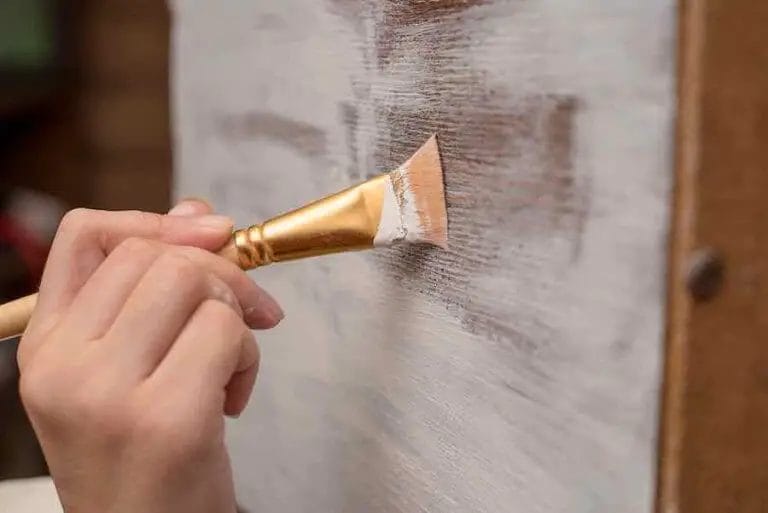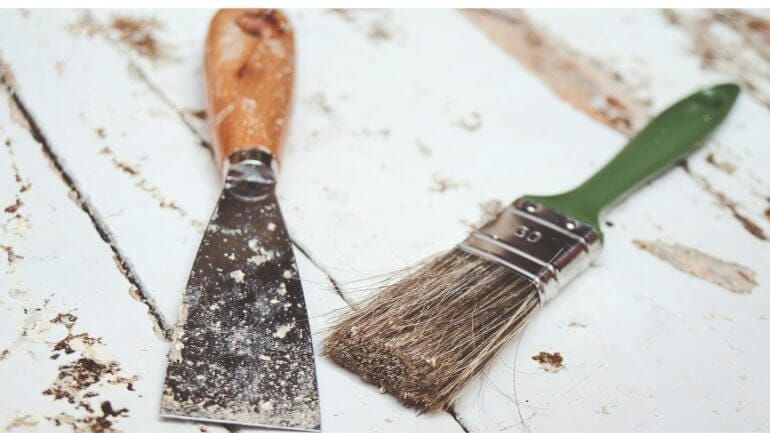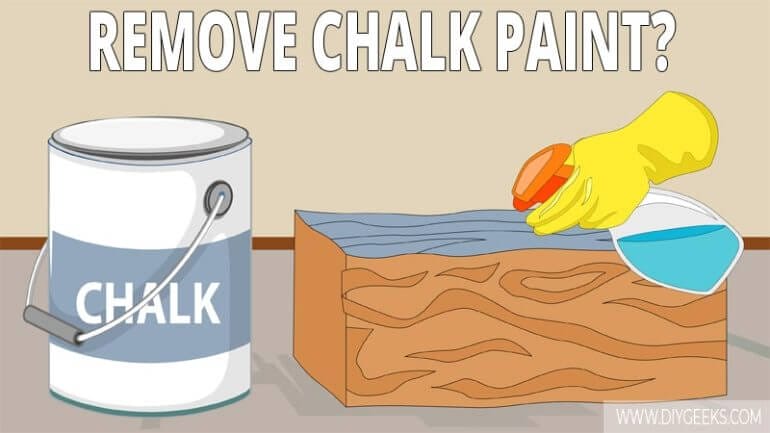Looking to remove chalk paint from wood? We’ve got you covered! Whether you’re tackling a furniture restoration project or simply want to revamp your wood surfaces, removing chalk paint can be a breeze with the right techniques. In this guide, we’ll walk you through effective methods to safely and efficiently strip away chalk paint from wood, leaving you with a clean and smooth surface ready for a fresh start. Let’s dive in!
Chalk paint, known for its matte finish and easy application, has gained popularity in the world of DIY projects. However, if you’re looking to change the color or get back to the original wood finish, it’s important to know how to properly remove chalk paint without damaging the wood underneath.

One method to remove chalk paint from wood is by using a chemical paint stripper. These products work by breaking down the paint’s bond with the surface, making it easier to scrape or wipe away. Before using any chemical strippers, make sure to read and follow the instructions carefully to ensure your safety and achieve the best results.
Another option is heat. Using a heat gun or a hairdryer set to high heat, you can gently warm up the chalk paint, causing it to soften and become easier to remove. Be cautious not to hold the heat source too close to the wood or for too long, as this may cause damage. Always keep the surface well-ventilated while using heat.

Gentle and Safe Methods to Remove Chalk Paint without Damaging Wood
If you’ve ever worked with chalk paint, you know how versatile and forgiving it can be. However, there may come a time when you need to remove chalk paint from wood surfaces without causing any damage. Whether you want to update the look of an old piece of furniture or fix a mistake, it’s important to use gentle and safe methods to ensure the integrity of the wood is preserved. In this section, we’ll explore some effective techniques for removing chalk paint without harming the underlying wood.
1. Sanding
Sanding is one of the most common methods used to remove chalk paint from wood. It involves using sandpaper or a sanding block to gradually remove the paint layer by layer. Start with a coarse-grit sandpaper and gradually move to finer-grit sandpapers until the paint is completely removed. This method requires some elbow grease, but it is effective and safe for most wood surfaces.
2. Chemical Paint Strippers
If sanding doesn’t appeal to you or if you’re dealing with intricate woodwork, you can consider using a chemical paint stripper. Look for a paint stripper specifically designed for removing chalk paint, as these are often gentler on the wood. Follow the instructions provided on the product packaging and make sure to wear protective gloves and eye protection. Apply the stripper to the painted surface, let it sit for the recommended amount of time, and then scrape off the softened paint using a plastic scraper or a putty knife.
3. Heat Gun
Another method to remove chalk paint from wood is by using a heat gun. This method is particularly useful for larger surfaces. Set the heat gun to a low or medium setting and aim it at the painted surface. Move the heat gun back and forth, keeping it at a safe distance to avoid scorching the wood. As the paint softens, use a plastic scraper to gently scrape away the paint. Be cautious not to hold the heat gun in one spot for too long, as it can damage the wood.
4. Vinegar Solution
If you prefer a more natural approach, you can create a vinegar solution to remove chalk paint from wood. Mix equal parts white vinegar and water in a spray bottle. Spray the solution onto the painted surface and let it sit for a few minutes. Use a clean cloth or a soft-bristle brush to gently scrub away the paint. This method may require some patience and multiple applications, but it is safe for most types of wood.
5. Citrus-based Solvents
Citrus-based solvents are another gentle and effective option for removing chalk paint from wood. These solvents are typically less harsh than traditional paint strippers and can be found at most home improvement stores. Apply the solvent to the painted surface using a clean cloth or sponge, and let it sit for a few minutes. Use a plastic scraper or a soft-bristle brush to gently remove the softened paint. Wipe away any residue with a clean cloth soaked in soapy water.
Summary
When it comes to removing chalk paint from wood without causing damage, it’s essential to use gentle and safe methods. Sanding, chemical paint strippers, heat guns, vinegar solutions, and citrus-based solvents are all effective options to consider. Remember to always follow the instructions provided by the product manufacturers and take necessary safety precautions. By using these methods, you can safely remove chalk paint from wood surfaces and restore their natural beauty.

Step-by-Step Guide on Removing Chalk Paint from Wooden Furniture
Chalk paint has become a popular choice for giving wooden furniture a vintage, shabby-chic look. However, if you decide that you no longer want the chalk paint on your furniture, removing it can be a bit tricky. In this section, we will provide you with a step-by-step guide on how to effectively remove chalk paint from wooden furniture without damaging the surface.
1. Gather the necessary materials
Before you begin the process of removing chalk paint, gather the following materials:
- Plastic drop cloth or newspapers
- Protective gloves
- Paint scraper or putty knife
- Fine-grit sandpaper
- Denatured alcohol
- Clean rags
- Mild soap and water
2. Prepare the workspace
Start by laying down a plastic drop cloth or newspapers to protect your work area from any potential mess. This will make the clean-up process much easier.
3. Test in an inconspicuous area
Before proceeding with the entire furniture piece, it’s important to test the removal method in an inconspicuous area to ensure that it doesn’t damage or discolor the wood. Choose a small, hidden spot and apply the removal method you plan to use to see if it is suitable for your particular piece of furniture.
4. Scrape off the chalk paint
Using a paint scraper or putty knife, gently scrape off as much of the chalk paint as possible from the surface of the wooden furniture. Be cautious not to apply too much pressure, as this can cause damage to the wood. Remove as many layers of paint as you can using this method.
5. Sand the surface
After scraping off the majority of the chalk paint, use fine-grit sandpaper to gently sand the surface of the furniture. This will help to remove any remaining paint and create a smooth finish. Sand in the direction of the wood grain to avoid causing scratches.
6. Apply denatured alcohol
Moisten a clean rag with denatured alcohol and gently rub it over the painted surface. The alcohol will help to break down the remaining paint and make it easier to remove. Continue rubbing until the paint starts to lift off the wood.
7. Clean the furniture
Once the majority of the paint has been removed, clean the furniture with a mixture of mild soap and water. This will help to remove any residue or remaining paint particles. Wipe the furniture down with a clean, damp cloth and allow it to dry completely before proceeding.
8. Repeat if necessary
If there are still traces of chalk paint on the furniture after following the previous steps, repeat the process until the desired results are achieved. It may take multiple attempts to completely remove all traces of the paint.
9. Finish with a protective coat
After successfully removing the chalk paint, consider applying a protective coat, such as wax or polyurethane, to the wooden furniture. This will help to seal the wood and protect it from future damage.
In summary, removing chalk paint from wooden furniture requires patience and careful execution to avoid damaging the wood. By following this step-by-step guide, you can effectively remove the chalk paint and restore the natural beauty of your wooden furniture.

Proven Tips and Tricks for Removing Stubborn Chalk Paint from Wood
Chalk paint has gained popularity in recent years due to its matte and vintage finish. It is a versatile paint that can be used on various surfaces, including wood. However, removing chalk paint from wood can be a challenging task, especially if it has been applied in multiple layers or if it has dried for a long time. In this section, we will explore some proven tips and tricks for effectively removing stubborn chalk paint from wood.
1. Use Heat
One of the most effective ways to remove chalk paint from wood is by using heat. You can use a heat gun or a hairdryer to soften the paint and make it easier to scrape off. Hold the heat source a few inches away from the painted surface and apply heat in a sweeping motion. As the paint softens, gently scrape it off using a putty knife or a plastic scraper.
2. Try Chemical Strippers
If heat doesn’t do the trick, you can opt for chemical strippers. There are various types of chemical strippers available in the market specifically designed for removing paint from wood. Make sure to choose a stripper that is suitable for your type of wood and follow the application instructions carefully. Apply the stripper with a brush or a sponge, let it sit for the recommended time, and then use a scraper to remove the softened paint.
3. Sanding
If the previous methods don’t yield satisfactory results, sanding can be the next option. Start by using coarse-grit sandpaper to remove the top layers of paint. Gradually switch to finer grits as you get closer to the wood surface. Sanding not only removes the paint but also smoothens the wood surface, readying it for a fresh coat of paint or stain.
4. Use Vinegar and Water Solution
If you prefer a more natural approach, you can try a vinegar and water solution to remove chalk paint from wood. Mix equal parts of white vinegar and water in a spray bottle. Spray the solution onto the painted surface and let it sit for a few minutes. Scrub the area with a stiff brush or a sponge until the paint starts to loosen. Rinse the wood with water and repeat the process if necessary.
5. Use a Paint Stripper Gel
An alternative to chemical strippers is a paint stripper gel. These gels are applied to the painted surface and left to sit for a specific period. The gel will soften the paint, allowing you to scrape it off easily. Follow the manufacturer’s instructions for application and safety precautions when using a paint stripper gel.
6. Combination Method
In some cases, a combination of methods may be required to remove stubborn chalk paint from wood. You can start by using heat to soften the paint, then follow up with a chemical stripper or sanding to remove any remaining residue. Experiment with different methods to find the best approach for your specific situation.
In Summary
Removing stubborn chalk paint from wood can be a challenging task, but with the right techniques, it can be done effectively. Whether you choose to use heat, chemical strippers, sanding, vinegar solution, paint stripper gels, or a combination of methods, be sure to follow the instructions carefully and take necessary safety precautions. By utilizing these proven tips and tricks, you can successfully remove chalk paint from wood and restore its natural beauty.
Quick and Easy Solutions for Removing Chalk Paint Residue from Wood
Chalk paint has become a popular choice for giving furniture and other wooden items a vintage or distressed look. However, removing chalk paint residue from wood can sometimes be a challenge. If you’ve recently used chalk paint and are facing the dilemma of how to remove the residue, don’t worry – we’ve got you covered. In this section, we will discuss some quick and easy solutions to help you get rid of chalk paint residue from wood.
1. Sanding
Sanding is one of the most effective methods for removing chalk paint residue from wood. All you need is a medium-grit sandpaper and a sanding block or electric sander. Start by sanding the surface of the wood in the direction of the grain. Apply light pressure and keep sanding until the chalk paint residue is completely removed. Make sure to wipe away any dust or debris that accumulates during the sanding process.
2. Vinegar Solution
Another easy solution for removing chalk paint residue is using a vinegar solution. Mix equal parts of white vinegar and water in a spray bottle. Spray the solution onto the affected areas and let it sit for a few minutes. Then, use a clean cloth or sponge to gently scrub the residue away. Rinse the surface with water and dry it thoroughly.
3. Mineral Spirits
If the chalk paint residue is stubborn and difficult to remove, you can try using mineral spirits. Wear gloves and work in a well-ventilated area when using this method. Apply a small amount of mineral spirits onto a clean cloth and gently scrub the residue. Be careful not to apply too much pressure, as it may damage the wood. Once the residue is removed, wipe the surface with a damp cloth and allow it to dry.
4. Baking Soda Paste
Baking soda is known for its cleaning properties and can be used to remove chalk paint residue from wood. Create a paste by mixing baking soda with water until you achieve a toothpaste-like consistency. Apply the paste to the affected areas and let it sit for about 15 minutes. Use a soft-bristle brush or sponge to gently scrub the residue away. Rinse the surface with water and dry it thoroughly.
5. Commercial Paint Remover
If none of the above methods work, you can opt for a commercial paint remover specifically designed for removing chalk paint. Follow the instructions provided by the manufacturer and make sure to wear protective gloves and goggles. Apply the paint remover onto the residue and allow it to penetrate for the recommended time. Use a scraper or a scrub brush to remove the softened residue, and then rinse the surface with water.
In summary, removing chalk paint residue from wood doesn’t have to be a daunting task. With the right techniques and solutions, you can easily restore your wooden items to their original state. Whether you choose to sand, use a vinegar solution, mineral spirits, baking soda paste, or a commercial paint remover, always remember to take necessary precautions and test the method on a small, inconspicuous area first. Now you can confidently tackle the chalk paint residue and enjoy the beauty of your wood furniture or décor.
FAQs
How can I remove chalk paint from wood?
To remove chalk paint from wood, first, gently scrape off as much paint as possible using a plastic scraper or putty knife. Then, apply a paint stripper or mineral spirits to a cloth and wipe the surface in the direction of the wood grain. Rinse with clean water and dry thoroughly. Repeat if necessary.
Can I use sandpaper to remove chalk paint from wood?
Yes, sandpaper can be used to remove chalk paint from wood. Start with a coarse grit sandpaper and gradually work your way to a finer grit. Sand in the direction of the wood grain until the paint is removed. Remember to clean the surface thoroughly after sanding.
Is it possible to remove chalk paint without damaging the wood?
Yes, it is possible to remove chalk paint from wood without damaging the surface. Use gentle techniques such as scraping and using paint strippers or mineral spirits. Avoid using harsh abrasive methods that can scratch or damage the wood. Test any products or methods in a small, inconspicuous area first.
Conclusion
In conclusion, removing chalk paint from wood can be a challenging task. However, with the right techniques and tools, it can be accomplished successfully. Whether you opt for sanding, using a chemical stripper, or a combination of both, it’s important to approach the process with caution and patience.
Remember to always test any chemicals or solvents on a small, inconspicuous area before applying them to the entire surface. Additionally, wearing proper protective gear and working in a well-ventilated area is crucial for your safety.
By following these guidelines and taking your time, you can effectively remove chalk paint from wood, revealing the natural beauty beneath and giving your furniture or surfaces a fresh start.
